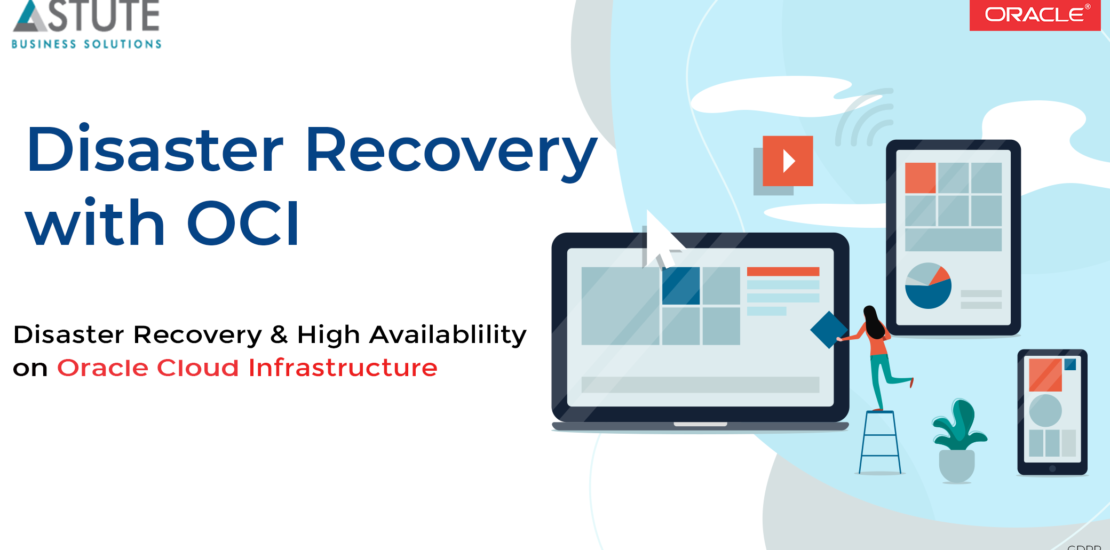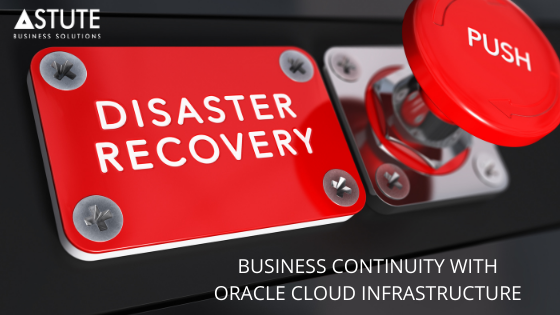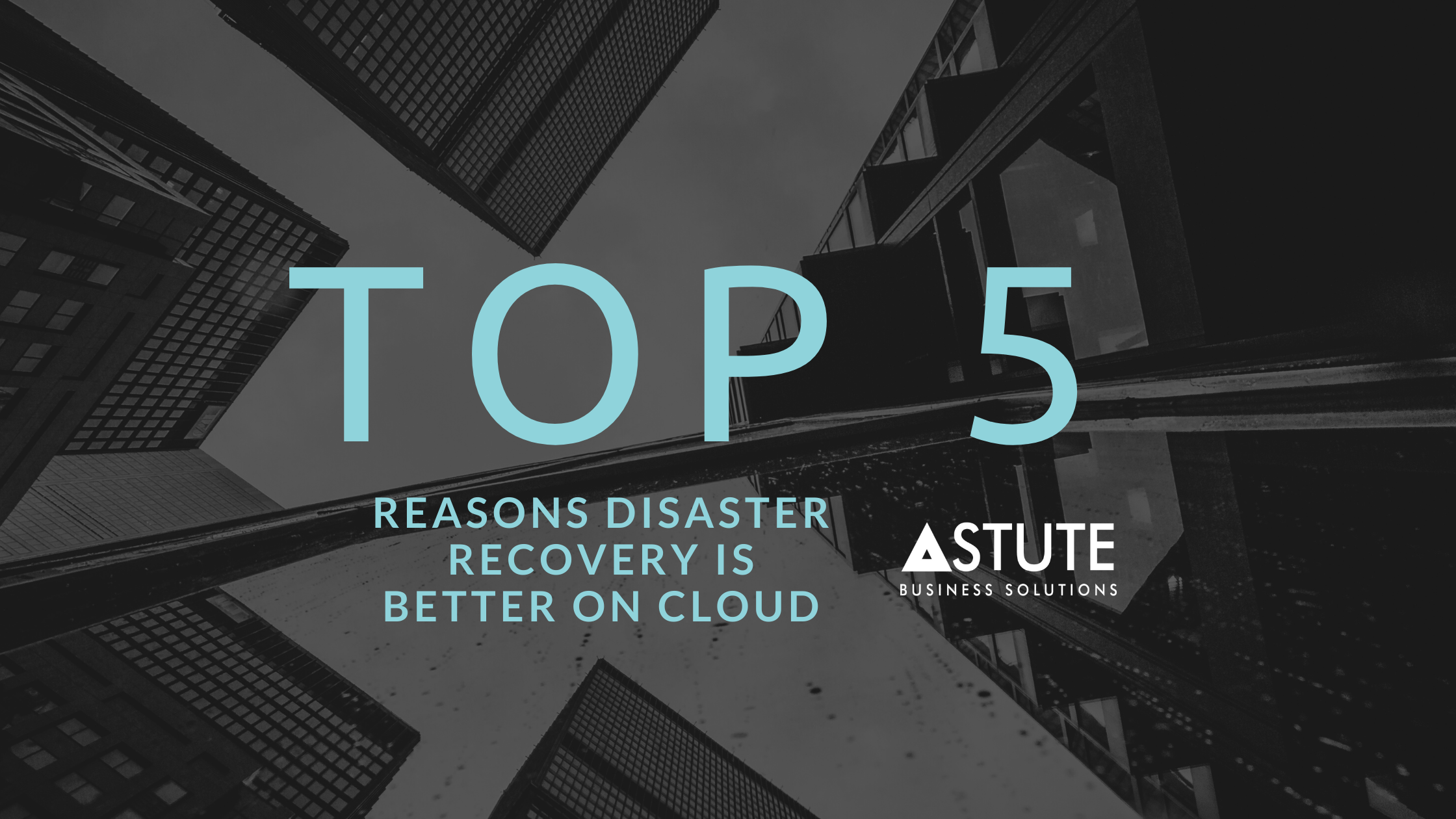
Disaster Recovery on Oracle Cloud
Table of Contents
Data is the most valuable asset for any organization today. Data includes Intellectual property, financial transactions, PII (Personally Identifiable Information), and CRM (Customer Relationship Management) data among others. Organizations today and in the future will rely more on data than any other asset to gain an edge on their competition, create business insights, and compete.
We have all heard horror stories where a single mistake or a lost or incomplete backup led to costly business disasters and have set businesses back days, weeks or months, from which they struggle to recover. The magnitude of the damage that can be caused by unpredicted outages – ‘natural’ or ‘man-made’, is unimaginable, and extremely fatal to business operations.
The aftermath of an outage can include loss of revenue, possible litigation, loss of business, and company credibility. Hence, protecting an organization’s data is the paramount responsibility of customers and their IT and business leaders.
Planning for the unknown can be difficult and implementing and maintaining an effective Disaster Recovery plan has been challenging in the past. Traditional approaches such as backup to disk, archiving to tape, and setting up failover systems in secondary data centers are riddled with faults, expensive and almost impossible to maintain and keep current.
With the fast pace of innovation and lowering the cost of public cloud infrastructure, Customers are increasingly looking to Cloud for Disaster Recovery solutions. Furthermore, Customers are looking for managed services that leave the implementation, testing and maintenance of Disaster Recovery solutions to expert partners who specialize in this area and are much better at keeping up with the latest technical innovations than their internal IT teams will ever be.
Disaster Recovery on OCI
Oracle’s world-class Disaster Recovery (DR) solutions optimized for PeopleSoft, Oracle EBS, JD Edwards, Siebel, Primavera and Agile ERP applications, are a well-constructed set of best practices, techniques, and architectures with low complexity levels, and are a long-term assurance of business operability in the aftermath of a disaster. These solutions largely allow businesses to upgrade from their otherwise archaic rigid business continuity plans to leverage a new level of control and flexibility.
In this article, we’ll discuss the benefits and best practices of Disaster Recovery on Oracle Cloud.
How Does OCI Deliver for Oracle Applications?
The Oracle Cloud Infrastructure (OCI) essentially helps design and deploy cutting-edge advanced backup and recovery plans with high-security data storage that is bound to immensely simplify your business processes. Oracle Disaster Recovery solutions offer state-of-the-art technology recovery services for all Oracle application environments, on-premises-to-Cloud (Hybrid), or in Cloud disaster recovery scenarios.
PeopleSoft Applications are now secure at various levels - through the application layer ensuring recovery of Application Data, Application Servers, Batch Process Scheduler Servers, and Databases. Disaster Recovery (DR) for Oracle JD Edwards EnterpriseOne on the Oracle Public Cloud data is replicated on a regular basis between production and standby sites for both the Database and Application layers
Also, Disaster Recovery for Oracle’s E-Business Suite customers provides maximum availability, scalability, and cutting-edge performance by expediting application response time and increasing server utilization and offloading resource intensive processing. These solutions have high-end capabilities that can validate disaster recovery readiness and eliminate downtime during planned events, with businesses having a unique tolerance limit for downtime.
Oracle practically offers customized recovery plans to handle a multitude of business continuity scenarios - building a solution on the Oracle Cloud, deploying the Disaster Recovery solution as a mirrored production environment, or the Oracle High Availability Architecture that can virtually reduce downtime and minimize data loss.
Key Business Benefits of a Solid Disaster Recovery Solution
The largest key benefit of a well-designed Disaster Recovery plan in place is the level of disaster preparedness itself and is concerned with saving the business from the cost of downtime, and ensuring that the data remains accessible and secure, even at the occurrence of an unexpected event. Oracle Disaster Recovery solutions provide the following concrete benefits to businesses:
- Limit losses through reduced restore times. Largely reduces the restore times of business information systems to be able to limit losses - not only in terms of revenues but also costs for possible damage caused by downtime and management and IT capital.
- Safeguard key business operations and mission-critical applicationswhilst minimizing interruption of critical processes Allows mission-critical processes to remain active and vital for business continuity, and possible interruptions are minimized by allowing a controlled resume time for operations.
- Granular management of replications. Restoring data can be done at file-level or smaller units with the core aim of complete recovery of data and services.
- Customization of your own Disaster Recovery solution. The ability to customize, control, and continually monitor your own Disaster Recovery solution along with personalization allows selection of the replication frequency to be able to establish the best recovery times for your business. The processes within this plan can include server and network restoration, provisioning backup systems, and copying backup data.
Build a digitally resilient environment
Implement a safe disaster recovery plan for your working infrastructure.
The following is a list of additional benefits you’ll gain with Disaster Recovery solutions on OCI:
1. Resilience and Reliability
Disaster Recovery with Oracle Cloud Infrastructure largely reduces the restore times of business information systems to be able to limit losses – not only in terms of revenues, but also costs for possible damage caused by downtime and management and IT capital.
While customers can spend a lot of money in modernizing their data centers with the latest in hardware technology with systems that are resistant to failures, they still won't be immune to hard disk or internet connection failures. The best on-premise hardware solution is only as good as its weakest link, of which there can be many and it can be costly for your organization to eliminate all such weak points. You can have one of the most well-crafted ships ever made, but if your crew can’t see the iceberg just beyond your line of sight, then it doesn’t matter upon impact.
Oracle Disaster Recovery, on the other hand, relies not only on the latest hardware technology but on hyper-scale and the ability to provide redundant solutions at a scale that can be leveraged by thousands of customers at once, hence being able to provide it at a very nominal unit cost for your organization. Public cloud infrastructure providers like Oracle have invested heavily in building and expanding a global network of regions and availability domains (roughly translated to data centers) that give any customer the scale, reliance, and fault tolerance they may need, from the simple to the most stringent of needs.
With Cloud Disaster Recovery, the overheads of deploying, maintaining, upgrading or refreshing hardware are entirely in the hands of the Cloud Provider and customers can focus only on consuming the As-A-Service model to implement their business continuity plans.
2. Safeguard key business operations and mission-critical applications
Oracle Cloud Disaster Recovery solutions typically offer higher security than comparable on-premise solutions. Cloud tenants are isolated from one another and workloads within a tenant can also be isolated based on business needs. Compliance requirements regarding data encryption, cryptographic algorithms, and key management can be met with native solutions that all major providers include in their core services today.
Security controls are easy to set up and use to segregate access and segregate operational responsibilities. Cloud provides visibility with log data and security analytics for auditing purposes. Customers have the choice of using cloud-native security solutions or bringing their own security assets to the cloud.
Fault independent cloud data centers enable high availability and are resilient against attacks. Cloud provides pen-testing and vulnerability scanning along with third-party audits and certifications as well as the ability to safeguard key business operations and mission-critical applications whilst minimizing interruption of critical processes
This allows mission-critical processes to remain active and vital for business continuity, and possible interruptions are minimized by allowing a controlled resume time for operations.
3. Granular Management of Replications
The ability to facilitate replications on a granular level is an essential component of a vigorous database management system. With Oracle Disaster Recovery, restoring data can be done at file-level or smaller units with the core aim of complete recovery of data and services.
4. Customization of your Own Disaster Recovery Solution
Oracle Database Disaster Recovery solutions provide businesses with the ability to customize, control, and continually monitor their own Disaster Recovery solution along with personalization that allows the selection of the replication frequency to be able to establish the best recovery times for your business. The processes within this plan can include server and network restoration, provisioning backup systems, and copying backup data.
While traditional Disaster Recovery systems have been designed to be mirror images of production systems, Cloud offers customers choice. Customers can start with fractional copies of their on-premise production workloads and only pay for that fractional consumption for the majority of the time. In the event of a disaster, Cloud provides automation and tooling that enables you to scale up that fractional system to a full-sized system in a matter of minutes for small-scale systems and hours for large-scale systems.
Disaster Recovery on Oracle Cloud Infrastructure further allows you to throttle the cost of these fractional footprints by only maintaining images of servers on Cloud storage that are refreshed using automated tools at a set frequency. You only incur minimal storage costs to store these images in the Cloud and pay for the full cost of the server only when you actually deploy an instance on Cloud using that image.
5. Cost-efficiency
Traditional Disaster Recovery is expensive not only because of the costs to procure and set up physical servers at a secondary data center location, but also because of the overhead of supporting, maintaining, and testing those systems. Oracle Disaster Recovery, on the other hand, is less expensive than a traditional disaster recovery center.
From insanely low storage costs, to free network connectivity (VPN options), to being able to run fractional footprints of your on-premise workloads in the Cloud, that you can scale up to full capacity in the event of a true disaster, Cloud gives you a variety of options that on-premise data centers can never match.
6. Speed
In comparison to traditional on-premise Disaster Recovery solutions, Cloud is fast. Oracle Cloud Disaster Recovery steps are fast to deploy, manage, failover, failback and test because it can be completely automated.
For example, a Disaster Recovery for up to 100 workloads (servers, virtual machines) on-premise can be deployed on Cloud in less than a week and be fully operational with scheduled backups, scheduled synchronization with on-premise and automated monitoring and testing solutions built-in. In comparison, a similar solution on-premise would take weeks if not months to implement at 5x to 10x the cost of the Cloud solution.
An important factor the Cloud Disaster Recovery influences with its speed are the RPO/RTO ratio. Cloud can offer up to the second recovery for a business that needs it with zero data loss, and at the same time, be flexible enough to offer Recovery Time Objective (RTO) of 4 hours and Recovery Process Objective (RPO) of 15 minutes for a fraction of the cost of an equivalent on-premise solution.
7. Compatible with Oracle applications
The Oracle Cloud Infrastructure (OCI) essentially helps design and deploy cutting-edge advanced backup and recovery plans with high-security data storage that is bound to immensely simplify your business processes. Oracle Disaster Recovery solutions offer state-of-the-art technology recovery services for all Oracle application environments, on-premises-to-Cloud (Hybrid), or in Cloud disaster recovery scenarios.
PeopleSoft Applications are now secure at various levels - through the application layer ensuring recovery of Application Data, Application Servers, Batch Process Scheduler Servers, and Databases. Disaster Recovery (DR) for Oracle JD Edwards EnterpriseOne on the Oracle Public Cloud data is replicated on a regular basis between production and standby sites for both the Database and Application layers
Disaster Recovery for Oracle’s E-Business Suite customers provides maximum availability, scalability, and cutting-edge performance by expediting application response time and increasing server utilization and offloading resource intensive processing. These solutions have high-end capabilities that can validate disaster recovery readiness and eliminate downtime during planned events, with businesses having a unique tolerance limit for downtime.
Oracle Cloud ERP Disaster Recovery practically offers customized recovery plans to handle a multitude of business continuity scenarios - building a solution on the Oracle Cloud, deploying the Disaster Recovery solution as a mirrored production environment, or the Oracle High Availability Architecture that can virtually reduce downtime and minimize data loss.
8. High Availability Technologies
The High Availability model has practically transformed application performance with key available metrics in terms of maintenance of services, turnaround time for resuming services, and data restoration post outage. The Oracle High Availability Architecture optimized for all Oracle applications leverages high availability and data security and protection capabilities built into the Oracle Database with the following key takeaways:
- Minimizes risks associated with consolidating applications and databases onto the shared infrastructure that is typical of cloud deployments.
- Eliminates downtime and data loss exposure for crucial business functions, to offer the full potential of the cloud.
- Reduced costs where the public cloud can be leveraged for less critical applications where downtime and data loss have minimal impact on customer satisfaction or the bottom line.
- Delivers complete production capacity and cost savings by drastically cutting down almost 50% of deployment footprint - the Disaster Recovery runtime costs are half the production cost.
- Global coverage with secondary locations for failovers in multiple geographical regions to handle business exigencies and for retaining uninterrupted operations.
- Efficient load balancing to enable distribution of client requests across multiple application tier nodes, providing exceptional scalability and fault tolerance.
9. SLAs for Disaster Recovery
SLA’s for Disaster Recovery in the Cloud enables providers to address various issues upfront with small and medium-sized business (SMB) customers - boundaries, roles, and responsibilities of both the organization as well as the DRaaS provider.
With businesses now demanding more than just a high availability from their Cloud environment, Oracle offers the best-in-class SLA’s that cover the entire gamut of services including availability, manageability, and performance.
- Performance Commitment
Oracle guarantees optimum performance whilst ensuring consistency and accessibility and the ability to monitor and manage resources running on the Cloud in the event of a mission-critical breakdown.
- Availability
Oracle ensures commitment to uptime and connectivity ensuring continuity in operations of your workloads on the Cloud.
- Manageability
Oracle offers manageability SLA’s to ensure your control over the ability to manage, monitor, and modify resources round the clock.
- Identify the best-fit deployment model
Oracle helps customers choose the best-fit deployment model (public, private, or hybrid Cloud) that largely achieves business goals and requirements of confidentiality and integrity.
Revolutionized disaster recovery for you
Empower your organization with a robust disaster recovery plan
Best Practices for Disaster Recovery in Oracle Cloud Infrastructure
Oracle Disaster Recovery is a resilient solution for your business’s security and data management requirements. With innovation, control and flexibility in mind, Oracle provides solutions to protect an organization’s data and prevent unpredicted outages or problems.
Oracle’s compatibility with multiple platforms is another key element and the best practices start with taking advantage of the technology integrations. Disaster recovery on Oracle Cloud is also a competitive option that outperforms other cloud services such as AWS.
OCI and RackWare RMM for Disaster Recovery
Astutepartners with RackWare Inc. to use the Rackware RMM platform that provides a flexible and all-encompassing solution for cloud migration and Disaster Recovery. RackWare helps customers of all sizes and industries take advantage of the agility promised by Oracle Cloud Infrastructure for a cost-effective and fully automated Disaster Recovery solution.
Rackware's platform eliminates the complexity of protecting, moving, and managing large-scale applications, including critical business applications and their workloads into the Oracle Cloud.
It is now possible for enterprise customers to forgo the upfront purchase of duplicate recovery hardware, the cost of setup, configuring, and maintaining that hardware by leveraging Oracle cloud infrastructure.
Rackware RMM Migration/DR platform is a non-intrusive Agentless Technology with pre- and post- Migration Configuration Capabilities that is easy to set up and configure for complicated enterprise environments/applications. Rackware RMM supports both Linux and Windows-based workloads for migration to the Oracle Cloud Infrastructure.
Rackware RMM value proposition for enterprises in the Oracle Cloud is as follows:
- Non-disruptive / Live Captures -No agents installed, safe and secure replication of your production environments
- Network and Application Discovery - Automatically discover network configurations and applications allowing you to reconfigure them in the OCI environment during migration
- Universal DR Protection - RackWare support spans all physical and virtual confluences, even for complex environments with Large SQL Clusters, and Network Attached Storage
- Seamless Failback - To physical and virtual environments, for simple Disaster Recovery drills
- Cost Reduction - Orchestration engine for multiple policies of RPOs and RTOs based on tolerance to reduce costs with less expensive compute, network, and storage utilization.
Oracle Cloud is a Generation 2 enterprise cloud that delivers powerful compute and networking performance and includes a comprehensive portfolio of infrastructure and platform cloud services. Built from the ground up to meet the needs of mission-critical applications, Oracle Cloud supports all legacy workloads while delivering modern cloud development tools, enabling enterprises to bring their past forward as they build their future.
Our Generation 2 Cloud is the only one built to run Oracle Autonomous Database, the industry's first and only self-driving database. Oracle Cloud offers a comprehensive cloud computing portfolio, from application development and business analytics to data management, integration, security, artificial intelligence (AI), and blockchain.
Oracle Cloud Infrastructure is hosted in regions and availability domains. A region is a localized geographic area, and an availability domain is one or more data centers located within a region. A region is composed of three availability domains. Availability domains are isolated from each other, fault-tolerant, and very unlikely to fail simultaneously.
Availability domains do not share infrastructures such as power or cooling, or the internal availability domain network. All the available domains in a region are connected to each other by a low latency, high bandwidth network, which makes it possible to provide highly available connectivity to the Internet and customer premises, and to build replicated systems in multiple availability domains for both high-availability and Disaster Recovery.
Your personalized disaster recovery plan is waiting for you
Build a reliable working infrastructure with enhanced security.
Disaster Recovery with Oracle Cloud Infrastructure v.s. AWS
OCI and Amazon Web Services (AWS) have been the two biggest platforms dominating the DR market space, but with the following key differences:
- Cost and Payment Model
Largely, though the pricing and payment model from AWS is more affordable than OCI, it can get more complex in terms of renting virtual spaces based on different instances and requirements such as memory, CPU usage, and other specific configurations.
Clearly, Oracle has an advantage with its current offering - being at a discounted price for old customers who have already paid for licenses to Oracle applications such as PeopleSoft, Middleware, EBS, and databases should they choose to run their software in the cloud.
Amazon Web Services (AWS) offers the ‘pay-as-you-go’ fee model giving customers complete control over customization of services as they grow. Additionally, services for Oracle Cloud are billed at the list price.
- Market Placement
Oracle Cloud, with a very robust set of product offerings such as Oracle Enterprise Resource Planning, Oracle Enterprise Performance Management, and more have clearly established their technological expertise and presence in the software and software licensing solutions space. AWS entered the cloud computing market in 2006 and has also established multiple data centers across the globe with a huge market presence.
- Customer Support
Due to the magnitude of Cloud solution offerings from OCI and AWS, their support relies on a wide network and a partner community. The AWS Partner Network (APN) provides AWS-based businesses with technical, marketing, and go-to-market support for advancing specific business requirements, whereas, the Oracle Partner Network (OPN) provides businesses with actionable ability to migrate to cloud-based services. This network also allows businesses to drive their Oracle Cloud solutions with implementation specialists and enablement resources.
Though the payment model for AWS allows easy adaptability to fluctuation in business needs, organizations can pay for services on a pure requirement basis. However, Oracle Cloud users can largely leverage flexibility depending on how often they need to rely on services.
Astute Business Solutions for Oracle Disaster Recovery
With Disaster Recovery becoming a business imperative, enterprises are focused on optimizing their strategies in order to reduce risk and reducing cost. The cloud has come to play an important role in Disaster Recovery, offering services that leverage global data centers and flexible storage tiering for cost-effective yet robust Disaster Recovery replication targets. Oracle Disaster Recovery is the solution for today and for the future all businesses, across all industries.
Astute Business Solutions is a proven business leader in successfully moving Oracle workloads to OCI and has implemented a multitude of DR solutions on OCI for US and clients worldwide. We identify mission-critical applications and data and determine the technologies required for various types of backup and storage models.
We have revolutionized disaster recovery on Cloud offerings to incorporate high availability characteristics for all your business requirements. Our comprehensive disaster recovery management plans are powered to handle multiple data centers, a wide spectrum of Operating Systems, Oracle applications, databases, and hardware platforms and devices across the entirety of your enterprise. We strive to ensure that the SLA is economical and will provide the appropriate level of service without breaching any of the security, privacy, or regulatory obligations.
To learn more about Disaster Recovery on Oracle Cloud Service visit our website or schedule a meeting with an Astute team member.
Arvind Rajan is Co-Founder and CEO of Astute Business Solutions. He is leading the expansion of Astute services to include Cloud Managed Services, Disaster Recovery on Cloud, and Integration and Process Automation using Platform Cloud Services.
Search
Related Posts
Subscribe Our Newsletter
Gain access to exclusive insights, technical know-how and crucial knowledge from Astute experts.
Share Article
See The Team In Action
Upcoming Events
-1.png)
Reach Out
Ready to Connect?
Please fill the following form, we will get back to you within a business day.
Contact Form
Contact Us



